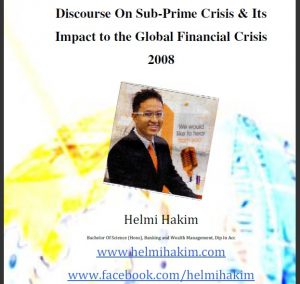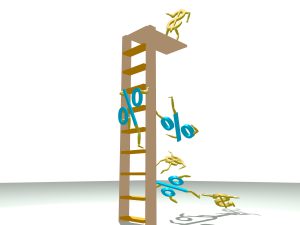
by Helmi Hakim | May 2, 2013 | Investment, Miscellaneous
When I meet, my non Muslim clients who are learning more about Islamic finance, sometimes they are curious, and they asked me, why Muslims cannot take interest. (riba)
Why, Muslims, cannot include speculative investments, like derivatives etc2, in their investment portfolio? (maysir)
I will normally answer, that God doesn’t allow us and stop at that. Today, I decide to blog about it. 🙂
Prohibition of interest and speculative activities are clearly mentioned in the Quran.
Allah S.W.T said in the glorious Quran, Surah Al Baqarah, Verse 275

“Allah has permitted trade and has forbidden interest”
Charging and earning interest is haram (forbidden) in Islam. Islamic finance advocates profit and risk sharing. If Islamic institutions lend out money, it becomes partners with the borrower in the venture. Profits and loss will be shared according to agreement.
…………………………………………………………………………………………………
…………………………………………………………………………………………………
Islamic finance also prohibits gambling and speculative activities
As stated in Surah Al-Maeda, Verse 90:

“O ye who believe! Intoxicants and gambling, (dedication of) stones, and (divination by) arrows, are an abomination,- of Satan’s handwork: eschew such (abomination), that ye may prosper.”
On the other hand, conventional banking and finance operation, accepts speculative financial instruments like derivatives.
……………………………………………………………………………………………
……………………………………………………………………………………………
When I research about every single financial crisis that has happened in this world, and I went deep to the root of it, I realised that it is always because of interest (riba) and speculation.
Subprime mortgage crisis, Euro Debt Crisis, Asian Financial Crisis, Baring’s Bank case, you name it, most of the financial crisis that have happened in the world were due to interest and speculation.

I have written a 24 page report on the subprime mortgage crisis that happened in the year 2008, and how it lead to the global financial crisis in the year 2009. You can scroll at the end of this blog post, input your email and download it immediately. Its FREE.
……………………………………………………………………………………………….
……………………………………………………………………………………………….
Speaking of subprime mortgage crisis, if we go to the root cause of it, it happened because of speculation and because people cannot afford to pay burgeoning interest from the loans they take. The subprime mortgage crisis happened because of the availability of subprime mortgage.
Subprime loan is a type of mortgage loan, being offered to those who are not qualified to get loans from mainstream lenders. These people are usually low income earners, first time borrowers or people who has a poor credit history.
Under normal circumstances, when people borrowed money from the bank, they were subjected to few criterias before their loan is approved.
They need to have strong credit scores and repayment histories, provide documentation for income and assets, and provide a down payment of 20% or alternatively purchase private mortgage insurance. If these criteria are fulfilled, their loan application is approved.
These groups of people are known as prime borrowers.
…………………………………………………………………………………………………….
……………………………………………………………………………………………………
However, competition amongst banks ensued, coupled with the view of treatment of loans as “assets” in the bank perspective, has lend to the lenience, of now, accepting loans for people who are previously not qualified.
Due to competition amongst banks, they now allow people who are previously not qualified to borrow. They are people whose FICO scores are under 660, defaulted on credit payment in the past 2 years or currently, owe more than half of their annual income in debt.
These people are called subprime borrowers. Their loan mortgages are known as adjustable rate mortgages.
……………………………………………………………………………………………………………………
…………………………………………………………………………………………………………………..
Adjustable rate mortgages have an initial interest rate. During the real estate bubble, many lenders offered mortgage loans with a very low initial interest rate designed to lure borrowers to loan products.
These very low interest rates, referred to as teaser rates, ended up getting a lot of borrowers into trouble. When the initial interest rate period ended, the interest rate and loan payment increased, sometimes drastically. This phenomenon has come to be referred as rate shock.
…………………………………………………………………………..
…………………………………………………………………………..

For example, the monthly payment for a $300,000 mortgage loan amortised over thirty years with an initial interest rate of 5% is $1,610.46.
If, after the initial interest period, the interest rate jumps to 10%, the monthly mortgage payment jumps to $2,632.71.
Thus, lots of borrowers cannot service their monthly mortgage payments, and then default on their payments. With the interest rates rise and housing prices fall, the borrowers do not have enough equity to refinance or sell.
So you can see here that the root cause of it is the adjustable rate mortgage where initially the interest rate is low, but subsequently, it skyrocket.
………………………………………………………………………………………
………………………………………………………………………………………
I will also touch on the speculative nature of human beings, thinking that property prices will always go up, till the property bubble happens. There are simply too many things to be discussed, and I have discussed it extensively in the report below. Key in your name and email below, and you can download it right away.


by Helmi Hakim | May 1, 2013 | Investment
I have written 2 blog posts, sharing with you on how options work. Click the link below to read them again.
1) http://helmihakim.com/investment/m9a-insurance-regulatory-exam-blog-post-no-1/
2) http://helmihakim.com/investment/m9a-insurance-regulatory-exam-blog-post-no-2/
…………………………………………………………………………………………..
……………………………………………………………………………………………
Now, you have a clearer understanding on how option works. In this blog post, I am going to share with you today on 4 most commonly use, option strategies. They are….
1) Covered Call Strategy
2) Protective Put Strategy
3) Bull Straddle (also known as Long Straddle) Strategy
4) Bear Straddle (also known as Short Stradel) Strategy
I have created the diagram below while studying for my finance degree, to sum up and make it as easy as possible to comprehend. ( You can click on the image to view the full image)

1) Covered Call Strategy
You own the stock and you sell call option.
2) Protective Put Strategy

You own the stock and you buy put option.
Example, you own XYZ shares. The share price now is $50/share. You anticipate a bad news announcement, and are afraid that the share price might goes down. So you buy a put option, with a strike price of $50, by paying a small premium. If the share price goes down to $30, its okay, because you have the right to sell it at strike price of $50.
It is like paying premium for term insurance policy. Death or total and permanent disability happens, family gets money. If nothing happen, you just forego the term insurance premium.
3) Bull Straddle Strategy

You buy call and put option at the same strike price and expiration date.
You do this when you expect that there will be a sharp move in stock’s price in either direction, during the life of the options. You profit from the increased votality in the underlying stock’s price.
Example, if you as the investor expects an important court ruling which outcome can be very GOOD or very BAD for the company, you employ a bull straddle strategy.
4) Bear Straddle Strategy

You sell call and put option at the same strike price and expiration date.
You do this when you expect the stock price to remain steady, and don’t move, thus allowing to earn option premium.
………………………………………………………………………………………………………
………………………………………………………………………………………………………
At first, it might be a bit difficult to grasp these 4 option strategies, because we, as financial advisors in Singapore hardly use this derivative instrument. However, it is crucial to understand, as we upgrade ourselves to be a competent financial consultants, to better service our clients.
Stay tuned for my next blog post! 🙂

by Helmi Hakim | May 1, 2013 | Investment
When the investor is bullish about the stock’s performance and expect stock’s price to go up, he buys (long) a ___________ option.
When the investor is bearish about the stock’s performance, and expect stock’s price to go down, he buys (long) a ____________ option.
………………………………………………………………………………………………………………………….
………………………………………………………………………………………………………………………….
If you cannot answer this question, do go back to my first blog post where I share more on buying call and put options.
http://helmihakim.com/investment/m9a-insurance-regulatory-exam-blog-post-no-1/
It is important that you understand the very basic first, because with very strong fundamentals, you can easily grasp the advanced ones later. Moreover, MCQ exams like M9A test more on your understanding, rather than just pure memory work. If you can answer the above correctly, do continue reading this blog post. 🙂
……………………………………………………………………………………………………………..
…………………………………………………………………………………………………………….
There are another group of people who wants to make money. They are the option sellers. They make money by SELLING (writing) a call or a put option. They make money by collecting the option’s premium that the option buyer pays.

Call Option Seller
If these group of people, expect the stock’s price to go down, they sell (write) a call option. They hope, that the price of the stock goes down, and those who buys call option (the investors, i mentioned in my previous blog post) never exercise their right to buy at strike price, since market price is already cheaper. The call option seller makes money, by collecting option premium.
Put Option Seller
Vice versa, if these group of people expect the stock’s price to go up, they sell (write) a put option. They hope, that the price of the stock goes up, and those who buys a put option, never exercise their right to sell at strike price, since the market price is already higher than the strike price. The put option seller makes money, by collecting option premium too! 🙂
Grasp and understand above, before you proceed to the last part of my blog’s post.
……………………………………………………………………………………………………………………………….. ………………………………………………………………………………………………………………………………..
Warning. There are dangers, of being a call or put option’s seller, if you don’t own the stocks.

You have UNLIMITED RISK. If you sell a call or put option without owning the stocks. We call it, that you are selling “naked”.
…………………………………………………………………………………………..
………………………………………………………………………………………….
Let me give you an example. You sell (write) a call option. The current price of the stock is $30. The strike price is $35.
The call option buyer expects the stock’s price to go up, so that he can buy at strike price and sell it for a profit on the open market. You as the call option seller, hopes the stock’s price to go down, praying that the call option buyer won’t exercise his right to buy at strike price of $35, and you can enjoy the option premium which he pays you.
5 days later, stock’s price jumps to $90. Call option buyer wants to exercise his right to buy the stock at $35. You don’t own the stocks. What, you have to do, is buy the stock from the open market at $90, and sell it back to the call option buyer at strike price of $35. Your risk is unlimited, because the stock price can go up, to $90, $100 or $200. You have no choice but to buy from the open market, and sell it to the call option buyer if you don’t own the stocks.
That is the danger of being an option seller, without owning the stocks in the first place. Your gain is just the option’s premium if option buyer never exercise his right, but your loss is unlimited if option’s buyer exercise his right.
………………………………………………………………………………………….
………………………………………………………………………………………….
I hope this sharing is beneficial for you and wait for my next post, which I will share more on option strategies.

Sharing is caring. Share this post around and may all benefit from it! Insya’Allah… 🙂

by Helmi Hakim | Apr 29, 2013 | Investment
I understand that some of my colleagues, in the finance industry find it challenging to pass the regulatory exam, M9A.
Thus, I will like to make a small contribution here. I will be writing a few blog posts, to help explain in a simple, easy to understand manner, concepts that you need to know, when you undertake the M9A exams. If you find it helpful, do share my blog post around! 🙂
…………………………………………………………………………………………………………………………………………………………..
…………………………………………………………………………………………………………………………………………………………..
In this blog post, I’m going to share more about buying a derivative instrument called options. 🙂
Most of us are familiar, that when we first get married, and want to buy a BTO house, we paid $2000 to “reserve” the house. This is an example of buying a “call option”.

When you buy (long) a call option, you attain the right but not the obligation to BUY the underlying assets (house) at specified price (strike price), within a specific period of time.
That $2000 that you paid, gives you the right but not obligation to buy the house. That $2000 is also known as the option’s “premium”.. Nobody else can buy your house, only YOU can buy the house, until the option expires.
…………………………………………………………………………………………………………………………………………………………………………..
…………………………………………………………………………………………………………………………………………………………………………..
In the real world, people buy a call option for stocks, if they are bullish, and expect the price of the stock to go up.

Example, the price of XYZ company shares now is $30/ share. You expect the price to go up to $60/share. The strike price is $35. You buy a call option by paying a fee, called premium.
When XYZ share price goes up to $60 before the option expires, you have the right to “buy” the stock at $35, and sell it at the open market for $60. Bingo!!! You make money!!! 🙂
…………………………………………………………………………………………………………………………………………………………………………
………………………………………………………………………………………………………………………………………………………………………..
Those who are pessimistic of the stock’s future performance, instead of buying a call option, they will buy (long) a put option.

Put option gives them the right, but not the obligation to SELL the underlying assets at specified price (strike price), within a specific period of time.
You know, people buy stocks at low price so that they can profit when they sell the stocks when the price goes up. But if stock’s price goes down, they cannot make money.
Buying a put option, allows them to make money even if the stock’s price goes down.
Example, XYZ company’s share price is now $60/share. You are bearish, and you expect XYZ company’s share price to go down to $30/share. The strike price is $55. When XYZ share price goes down to $30 before the option expires, you have the right to “sell” the shares at $55. You make money again! 🙂
…………………………………………………………………………………………………………………………………………………………………………
…………………………………………………………………………………………………………………………………………………………………………


Now you understand, that when the investor is bullish about the stock’s performance and expect stock’s price to go up, he buys (long) a call option.
When the investor is bearish about the stock’s performance, and expect stock’s price to go down, he buys (long) a put option.

There are another group of people who wants to make money, by SELLING (writing) a call or a put option. I will share with more on the benefits and danger, of being a call or put seller in my next blog post, but before that, just make sure you understand the concept of buying call and put option. Stay tuned! 🙂

by Helmi Hakim | Apr 25, 2013 | Investment
Today, I am going to share with you what most finance courses out there, dont teach you.
The Mechanics Behind The Formula Of Compound Interest! 🙂

In one of my previous blog post, I have shared on how to calculate compound interest, without using a financial calculator.
This is the formula again.
Principal (1+interest)number of years
In this blog post, I am going to share with you the mechanics behind the formula of compound interest for a single cashflow. Before that, let me give you an example, on how compound interest works.
Example, you have $10,000 today, and you earn 9% compounded interest, annually.
For the first year, you earn 9% X $10,000 = $900 interest
On the second year, you will earn an additional 9% X ($10,000 +$900) = $981 interest
You earn interest, not just on the principal…but you earn interest on the (principal + interest)
So total in 2 years, you make, $10,000 X (1.09) X (1.09) = $11,881
…………………………………………………………………………………………………………………………………………………………………………….
……………………………………………………………………………………………………………………………………………………………………………
The above explanation is pretty straight forward and it is pretty easy to calculate if we compound it for 2 or 3 years.
If we compound for 2 years, we take 10,000 X (1.09) X (1.09).
If we compound for 3 years, we take 10,000 X (1.09) X (1.09) X (1.09).
If we compound for 4 years, we take 10,000 X (1.09) X (1.09) X (1.09) X (1.09).
BUT what if we compound for 60 years? What are we going to do, if we dont have a financial calculator? Take….
10,000 X (1.09) X (1.09) X (1.09) X (1.09) X (1.09) X (1.09) X (1.09) X (1.09) X (1.09) X (1.09) X (1.09) X (1.09) X (1.09) X (1.09) X (1.09) X (1.09) X (1.09) X (1.09) X (1.09) X (1.09) X (1.09) X (1.09) X (1.09) X (1.09) X (1.09) X (1.09) X (1.09) X (1.09) X (1.09) X (1.09) X (1.09) X (1.09) X (1.09) X (1.09) X (1.09) X (1.09) X (1.09) X (1.09) X (1.09) X (1.09) X (1.09) X (1.09) X (1.09) X (1.09) X (1.09) X (1.09) X (1.09) X (1.09) X (1.09) X (1.09) X (1.09) X (1.09) X (1.09) X (1.09) X (1.09) X (1.09) X (1.09) X (1.09) X (1.09) X (1.09) ???
…………………………………………………………………………………………………………………………………………………..
…………………………………………………………………………………………………………………………………………………..
The mathematician who developed this formula makes it easy for us.. Just use this formula…
Principal (1+interest)number of years
Example if you have $10,000 and compounding it for 2 years at 9%/annum.
The formula goes 10,000 (1+0.09)2
which is also 10,000 X (1.09) X (1.09).
For the first year, you make (10,000 X 1.09) = $10,900 inclusive of interest, and the second year, you make (10,900 X 1.09) = $11,881
……………………………………………………………………………………………………………………………………..
…………………………………………………………………………………………………………………………………….
But if the $10,000 is compounded for 60 years, instead of inputting, 10,000 X (1.09) X (1.09) X (1.09) X (1.09) X (1.09) X (1.09) X (1.09) X (1.09) X (1.09) X (1.09) X (1.09) X (1.09) X (1.09) X (1.09) X (1.09) X (1.09) X (1.09) X (1.09) X (1.09) X (1.09) X (1.09) X (1.09) X (1.09) X (1.09) X (1.09) X (1.09) X (1.09) X (1.09) X (1.09) X (1.09) X (1.09) X (1.09) X (1.09) X (1.09) X (1.09) X (1.09) X (1.09) X (1.09) X (1.09) X (1.09) X (1.09) X (1.09) X (1.09) X (1.09) X (1.09) X (1.09) X (1.09) X (1.09) X (1.09) X (1.09) X (1.09) X (1.09) X (1.09) X (1.09) X (1.09) X (1.09) X (1.09) X (1.09) X (1.09) X (1.09),
just use this simple but powerful formula.
10,000 (1+0.09)60
Hope this explanation is beneficial for you…. 🙂

by Helmi Hakim | Apr 24, 2013 | Insurance, Investment, Miscellaneous, Motivation
Alhamdulillah Wa Shukrillah…. I have finally graduated with Bachelor Of Science (Hons) in Banking and Wealth Management, University Of Wales, UK, with first class honours. 🙂

It has been an uphill task thus far, juggling appointments with clients and school, but a rewarding and satisfying one.
I have made great friends along the way and learnt what it takes to be an empathic, professional and competent financial planner. Now, I have the time and resources to share what I learnt, and apply it fully onto my 600+ clients. Till then, I shall wait patiently, for our convocation in November 2013. Insya’Allah… 🙂























